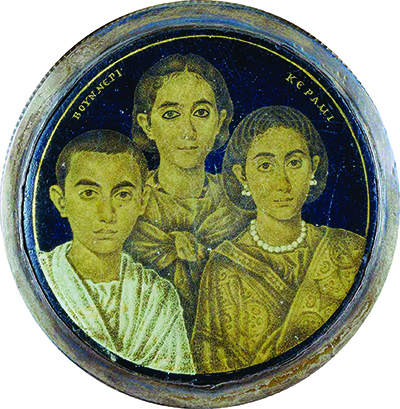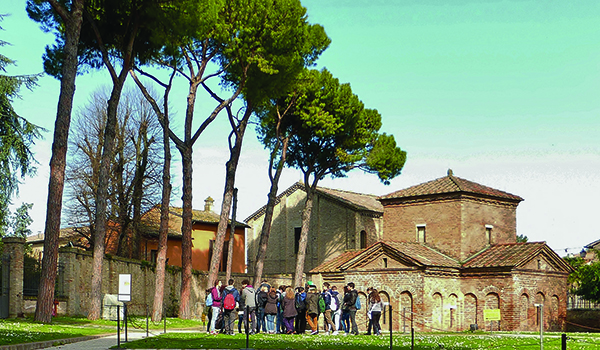In Ravenna, a Queen gives birth to a daughter whose actions precipitate the founding of Venice.
By the early 5th century AD, the Roman Empire was in two parts, ruled by two different emperors in two different capital cities. The eastern half was administered from Constantinople, in Thrace. The western capital was in Ravenna, in the marshes of the Po River delta, the better to discourage invading Goths and Vandals. Rome had not been the Empire’s capital since the time of Diocletian, a century before.
Rome, though, was still the magnificent “city of marble” of which Augustus had boasted. Merchants and politicians still met in the Forum. Romans still luxuriated in the opulent baths of Diocletian and Caracalla.
Aristocrats still dwelt on the Palatine, and the city’s temples and churches, including the first St Peter’s, held treasures of gold, silver, and precious stones. The Colosseum still wore its travertine coat, and the Pantheon gleamed with gilded bronze. Rome was still the symbol and soul of the Roman Empire.
So, in the summer of 410 AD, it was to Rome’s gates that Alaric, King of the Visigoths, brought his powerful army. Twice before he had threatened the city, and left after being bribed by the Western Emperor, Honorius.
Trapped inside the Aurelian walls, many Romans probably thought that Honorius, back in Ravenna, would make another deal to save the city. After all, Rome had not been sacked for 800 years.
Among those in Rome at this time was Honorius’s young half-sister, Galla Placidia. She was about 20 years old, beautiful, strong-willed, and wealthy.
Now she waited with the rest of the city for her brother’s intervention. Honorius, however, refused any further tribute to the Goth leader. Enraged, Alaric ordered his troops to sack the city and, on 24 August, his army forced a gate and streamed into Rome.
For three days the Goths looted the city, committing the usual cruelties, and then left carrying their plunder, including a particularly valuable prize, a captive Imperial princess.
Alaric died of a fever soon afterward, and the new king, Ataulf, led his followers north into southern Gaul. There, in Narbonne, Galla and Ataulf were married, more than three years after she was captured. It was a festive wedding, with much feasting and dancing, and the king gave his new bride many valuable gifts of Roman plunder.
Thus the young Roman princess, daughter of Theodosius the Great and half-sister of the Western Roman Emperor, became Queen of the Goths.
Their marriage seems to have been a harmonious one, though brief. Ataulf was assassinated less than two years after their wedding, and Galla was ransomed back to her Roman family in Ravenna. There she married, reluctantly, a prominent general, Flavius Constantius, and had two children, Justa Grata Honoria and Valentinian.

Her husband, for his military services, was named co-Emperor with Honorius; and once again, Galla Placidia was a Queen. Or rather, this time, Empress.
Constantius died after only seven months of rule; and soon, Galla faced a disturbing problem: the Emperor Honorius, her half-brother, apparently developed an inappropriate passion for her. Galla took her two children and fled to Constantinople, to the protection of the Eastern Emperor, her cousin Theodosius II.
However, barely two years after Galla sailed for Constantinople, Honorius died, leaving the western Imperial throne empty. Galla’s six-year-old son Valentinian was named Emperor of the Western Roman Empire. Galla and her children sailed back to Ravenna, nearly drowning in a storm on the way.
For 12 years, Galla skilfully ruled the Western Empire as Valentinian’s regent, fending off threats from Vandals and Huns, mediating disputes among her own nobles, and building the church of San Giovanni Evangelista in Ravenna, to thank God for saving her family from shipwreck.
She also commissioned Ravenna’s Church of Santa Croce, now in ruins, except for a small outbuilding rich with fine Byzantine mosaics, the oldest of the eight world-famous UNESCO World Heritage mosaic sites in Ravenna. It’s called the Mausoleum of Galla Placidia, though most modern scholars say Galla is buried somewhere in Rome.

Galla’s son was a mediocre Emperor, ill-equipped to save a dying empire. Her daughter, Justa Grata Honoria, is much more interesting. Honoria is said to have had contempt for her brother, the Emperor, and was frustrated by her life in what she felt was a dull backwater.
She had affairs, the most serious of which was with her Chamberlain, Eugenius. The affair was discovered, and Eugenius was executed. Valentinian then decided to marry Honoria off to a Senator named Flavius Herculanus, much to Honoria’s displeasure. Faced with the prospect of marriage to the worthy but dull Senator, Honoria took an astonishing step…
She sent her ring and a letter to Attila the Hun, asking him to come and rescue her. Attila was delighted, treated her letter as a proposal of marriage, and demanded half the Western Empire as dowry. Valentinian refused, and in the year 452, Attila invaded Italy, devastating the ancient province of Venetia, and razing its largest city, Aquileia, to the ground.
In terror, many residents sought shelter in the soggy islands of the Adriatic lagoons south of the ruined city. Attila finally withdrew from Italy, probably because disease broke out among his troops. After her Barbarian suitor left, Honoria disappeared from history. In time, the lagoon settlements became the city of Venice.
About the author:
Joe Gartman writes about travel, history and culture, and divides his time between the southwest US and Europe. Learn more at www.joegartman.com

